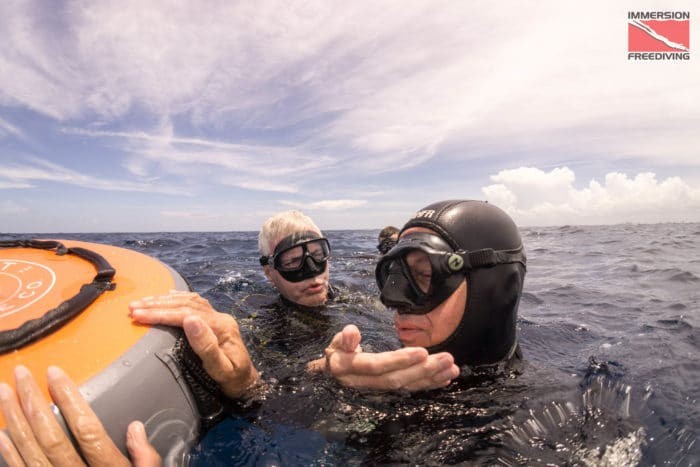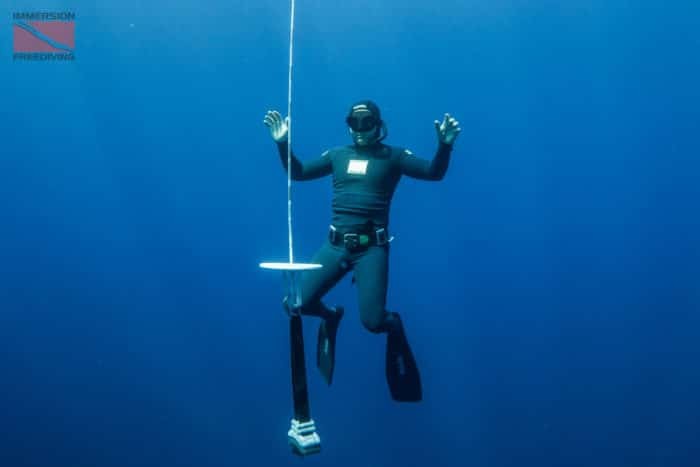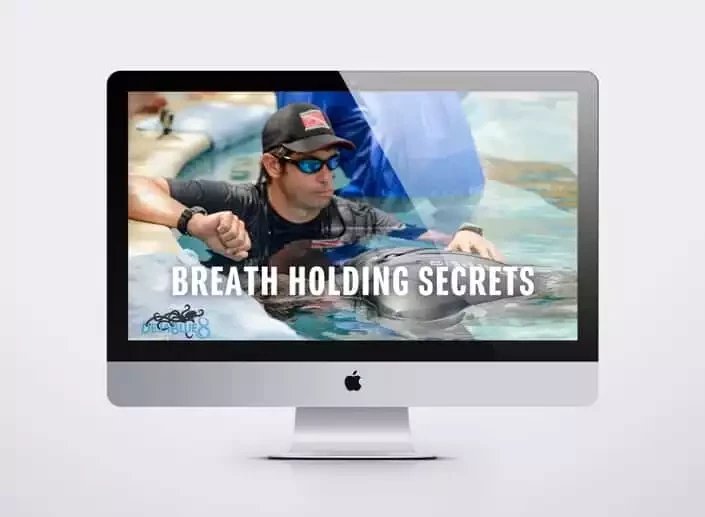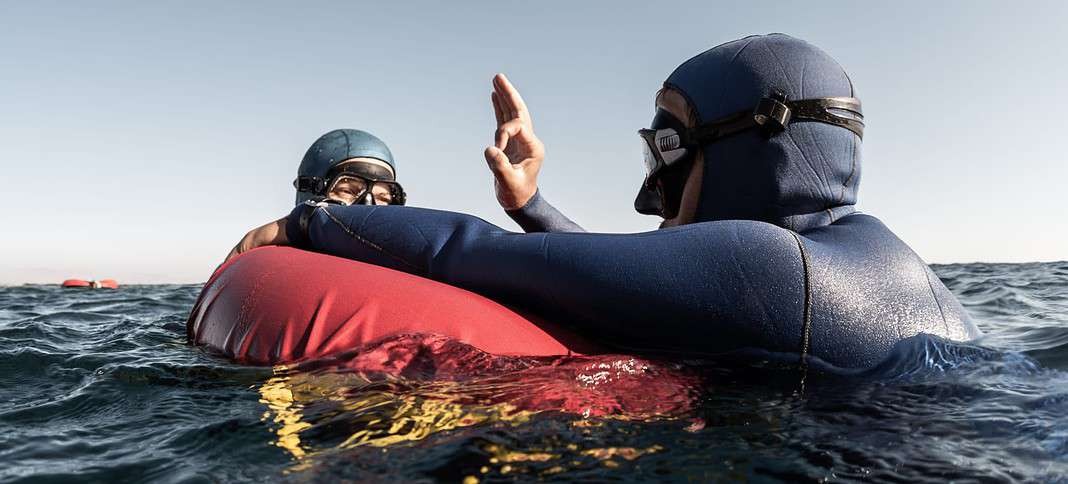Let’s face it, Freediving Safety is not an exciting topic, but why is it so important?
I like to use different language for the term freediving safety, I like to call it how to not kill yourself while you are freediving, and that’s what you are going to learn by reading this article.
I’m the founder of Immersion Freediving, as well as my new pride and joy FreedivingSafety.com, and a Performance Freediving Instructor Trainer.
I teach people to Freedive deeper, stay longer and become safer.
Let’s dive in!
The Concepts
Let’s define 3 concepts first then we will dive into the 3 safety rules.
#1 Loss of Motor Control
This is a mild hypoxic event. As we hold our breath, the oxygen levels get lower and lower. When they get too low, you can get a hypoxic event.
If a Freediver has a loss of motor control, here is what you might see. They might have blue lips, they might have trouble breathing in and out, and they will likely appear to be shaking. This last sign is where the term loss of motor control comes from.
If you had a loss of motor control, here is what you might feel. You might feel confused, euphoric, tingling in your fingers and toes, see tunnel vision or stars, and feel the uncontrollable movements or shaking.
They typically last 3-7 seconds, and in the end, the diver will be fine.
#2 Blackout
This is a major hypoxic event. When a Freediver has a blackout, they momentarily lose consciousness, and they lose the ability to keep their mouth and nose above the waterline. Without assistance, their airway would go underwater…this is bad.
If the Freediver is by themselves, this can result in the Freediver sinking to the bottom and eventually taking terminal gasp and inhaling the water into their lungs, resulting in their death.
The second MUCH BETTER outcome is the Freediver has a blackout, and there is a buddy close by who is trained in freediving rescue techniques and within seconds, the blacked-out diver is fine! Big yes for a well-trained buddy!
Loss of motor controls and blackouts are rare events in freediving, but the penalty for making a mistake in freediving is quite severe (ie, it can kill you), and that’s why it’s in your interest to consistently implement these three simple proceeders every time you freedive.
#3 The Rule of 9’s
I first learned the rule of 9’s from Kirk Krack the founder of Performance Freediving International. In fact of the things in this article, I learned from him back in 2009.
90% of the blackouts happen at the surface after the Freediver has taken 2 or 3 breaths. Often times they will hit the surface, look completely fine, give you an ok sign, and THEN they blackout.
Most of my students are shocked when I show them a video of a Freediver coming up from a dive taking two breaths, then giving the ok sign, and THEN having a blackout.
9% of the blackout happens between 15ft (5M) and the surface.
The Guidelines
By following the below simple guidelines, you will be protecting yourself where 99% of the blackouts occur.
#1 Be Close Enough To Grab
I believe that this simple concept is the SINGLE MOST IMPORTANT concept of safe freediving.
When you come up from a freedive, you want your buddy to be what I call close enough to grab. Why?
Because one of the most important rules in freediving is…..
Protect the airway

You are probably thinking, what does that actually mean? Well, we humans do very poorly with water in our lungs, said another way it kills us.
There are two entrances into the lungs, mouth, and nose. When a Freediver has a blackout, they are often overweighted and then sink underwater. This will eventually lead to water getting in the lungs, and that’s what kills us every time. It’s not the blackout that kills us, it’s the water in the lungs.
You need to be right next to your buddy when they surface so if they blackout, you can stop their airway (mouth and nose) from going in the water.
I will be going into great detail about how to recovery someone from a blackout in a future article, but the good news is this. If you are close enough to grab them, that’s 90% of the work. Just grab on to them, make sure they don’t sink, and keep their head above the water, which protects their airway.
People often say things like “I know not to dive alone, so my buddies and I are going to jump off the boat and all stay in the same area and ‘keep an eye’ on everybody.”
Unfortunately, I promise you that just doesn’t work, and here is why.
Where do most blackouts happen? At the surface, after 2 or 3 breaths.
I’ve NEVER seen a person having a blackout or a loss of motor control yell for help. Why? Because they don’t even know what planet they are on, they can barely breathe, they are shaking uncontrollably, and possibly not even conscious.
So they hit the surface take a few breaths, blackout, and often sink to the bottom. They are in trouble on the surface for no more than 5-10 seconds. If you are “in the area” but are face down looking underwater, or diving underwater, or shooting video, or searching for a fish to shoot, how would you see this?
You would not see this, and the person would likely sink to the bottom and die, even though you are “in the area”.
This is why the only way to provide safety to a Freediver is to commit to being close enough to grab when they surface, not just be “in the area.”
Why do I say 3 ft or close enough to grab? Because our arms are 3ft long. If you have 100ft long go-go gadget arms, then yeah, you can be 100ft away.
Think about it, if you are 100ft away, AND you are on the surface, AND you happen to be looking right at your buddy as they blackout and sink to the bottom, what can you do about it? You are 100ft away from them. You can watch them sink to the bottom and go yep just like Ted said down they go.
#2 Pass the Surface Safety Test
Unfortunately, most freedivers and spearfishermen wear too much weight. When you blackout, you will either float on the surface or end up on the bottom of the ocean or pool. Which sounds like a better place to end up? Exactly the surface!
Where you end up after a blackout is 100% determined by the amount of lead on your belt.
Because many Freedivers and spearfisherman don’t have a buddy close enough to grab AND they are wearing too much weight, you can see what happens. They blackout, then sink to the bottom, and then we have yet another easily avoidable fatality.
Here is how to determine if you are wearing too much weight.
This video clearly explains the process.
Jump in the water wearing whatever you normally wear. Take a big breath and do a relaxed exhale, like a sigh, not blow out everything. Watch the video to see exactly how much air.
Once you have done that relaxed exhalation, don’t move your feet and don’t move your hands. If you are continually sinking, that means if you blacked out wearing that much weight, you would end up on the bottom if you had a blackout. Does that seem like a good plan? Nope!
Take one pound off at a time until you can do a relaxed exhalation on the surface and no longer sink. I call this passing the surface safety test.
I teach my students to do this test every single time they jump off the boat. If you change your wetsuit, gain or lose weight, change from salt to fresh water, your weight needs to change as well.
In a freediving class, your instructor might have you do different tests, which are all excellent. I find many of those tests, like neutral at 33ft (5M) or positively buoyant after a relaxed exhale at 5M, are hard to do correctly outside of a freediving class. This one is easy to do. I even recommend once you no longer sink, take another pound off!

#3 Watch your buddy for no less than 30 seconds
You already know that when your buddies surfaces, they might look fine at first but then can later blackout out. The question then is how long do I have to keep an eye on my buddy.
After 30 seconds of breathing on the surface, it’s improbable they will then blackout because they are getting oxygen in for 30 seconds. I tell my students to watch their buddy for 30 seconds, and if they are good after that, they can go about their business.
BulletProof Buddy System
I remember when I first started freediving and spearfishing, I and my buddy would constantly be hollering at each other. We had both taken a freediving class, and we both were trying to be safe. What often happened is I would dive, I would assume my buddy is watching me, and when I’d hit the surface, I’d see her swimming 50ft away from me.
Then I would start hollering and say, “where the heck are you going your supposed to be watching me” and she would say, “no Ted you are supposed to be watching me!”
Here is the simple solution.
You and your buddy get in the water. One is designated the leader, the other is designated the follower. The leader gets to go WHEREVER they want, no discussing and no arguments. Your job as the follower is to stick your face in the water and follow their fin tips. When the leader makes a dive, you stay on the surface and will be there for them when they surface. Once the leader surfaces and you watch them for 30 seconds, you switch.
Now you are the leader, and they are the follower. It’s such a simple system and works incredibly well!
Dive safe out there it’s not even that hard.
 Breath holding secrets from a USA Freediving record holder
Breath holding secrets from a USA Freediving record holder
What will you do with your extra time underwater?

